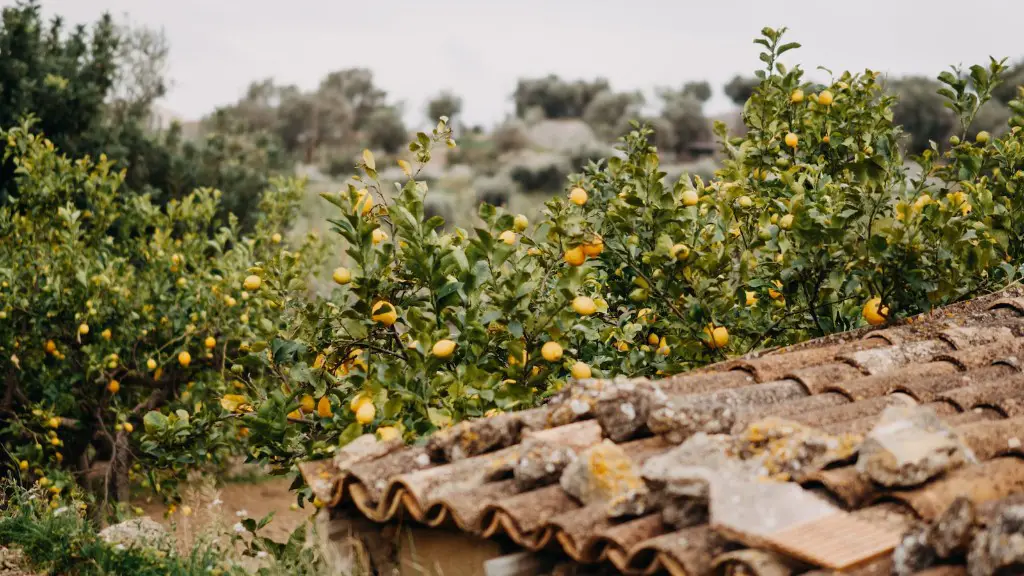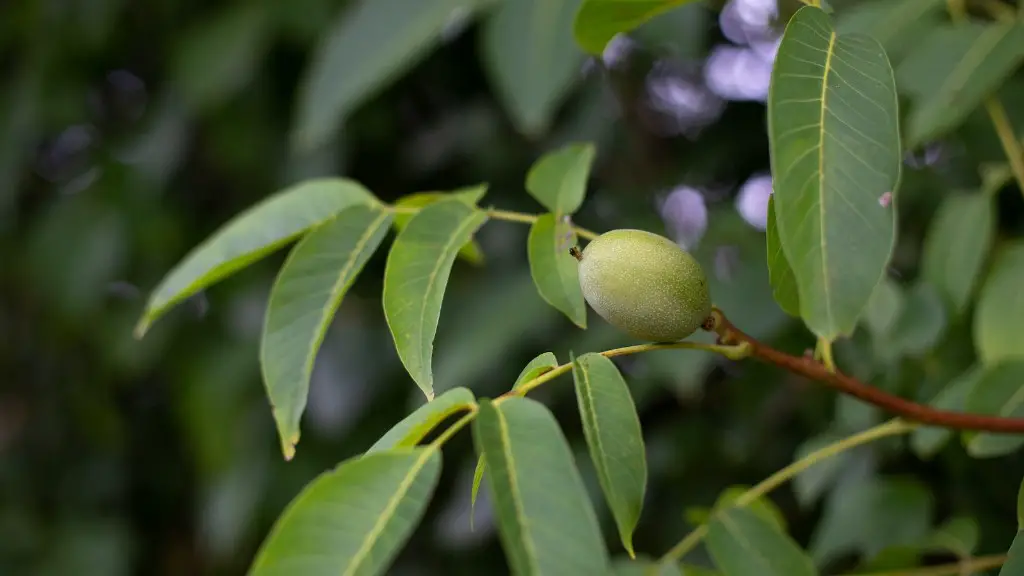Lemon trees are a familiar sight in many backyards and gardens. These trees have fragrant, pale yellow flowers that can be enjoyed not only by the gardener, but also by visitors and passers-by. The flowers on a lemon tree are a vivid reminder of the fresh, tangy scent that can be experienced when a lemon is picked off a tree. In this article, we’ll look at what flowers on a lemon tree are, how they look, and what kind of care they require.
The flowers of a lemon tree are white and very fragrant. They appear in abundance each spring, with some trees producing hundreds of flowers. They are delicate, yet strong, and open in the morning and close in the evening. They have five petals and a prominent yellow center, which often contains some green or pinkish markings. Each lemon flower typically measures between 0.5 and 1 inch in diameter.
When looking at lemon flowers, you may notice that the green sepals that hold them in place look somewhat like leaves. In fact, they are modified sepals, and they help to protect the fertile flower center. Along with the petals, they give the lemon flower its overall look.
The flowers on a lemon tree don’t just have a pleasant scent and visual appeal; they are crucial for the tree’s survival, since they help to produce the lemons that we enjoy. The flowers serve as a pollination site for bees and other insects, who carry the pollen from the anthers to the female parts of the flowers to transfer the male and female genetic material needed to produce lemons. If bees are not abundant, some gardeners employ manual pollination techniques, such as using a Q-tip to transfer pollen from the flowers to the female parts.
Lemon tree flowers require adequate water and lots of sunshine to stay healthy and productive. When it comes to fertilizers, fertilize sparingly once a year and always follow the manufacturer’s instructions. Lemon trees appreciate some mulch around the base of their stems, as this helps retain water and provides some added protection from weeds. Finally, if you’ve got a lot of flowers and lemons on the same tree, it’s a good idea to remove some of the fruits in order to allow the rest to grow larger.
Color and Fragrance of Lemon Flowers
Lemon flowers are typically pale yellow, but they can also range from cream to nearly white depending on the variety. They come in different shapes and sizes, and they have five petals each. While all types of citrus fruits have fragrant flowers, lemon flowers are particularly beloved for their strong, sweet and tangy aroma, which is immediately recognizable to anyone who likes the scent of fresh lemons.
The primary active ingredient in lemon flowers is citral, which is a small, water-soluble aldehyde that gives citrus fruits their refreshing, acidic scent. When lemon flowers are in bloom, the fragrance can become quite intense, filling even large gardens with their perfume.
While the scent of lemon flowers is pleasant, some people may find it too strong or perfumey, especially if they are sensitive to strong odors. If you’re one of these people, it’s best to avoid planting a lemon tree in your garden, as the scent can become overwhelming and easily overpower other plants.
Finally, lemon flowers are also sometimes used in natural beauty products, such as creams, lotions, and soaps. This is due to their calming, calming properties, as well as their ability to reduce redness and inflammation. The scent of lemon flowers is also known to be calming and uplifting, which can be beneficial if you’re feeling overwhelmed or stressed.
Uses for Lemon Flowers
There are many different uses for lemon flowers, from using them in natural remedies to perfumes and beauty products. Their calming scent is often used to make incense, potpourri, and essential oils. These essential oils can then be used for aromatherapy, massage therapy, and perfumery.
The flowers of the lemon tree are also sometimes used in cooking and baking. For example, dried and crushed lemon flowers can be added to salads, marinades, and sauces to bring out the citrus flavor. They can also be used as a decorative garnish for drinks and desserts. Lemon flowers are edible and can make a unique and flavorful addition to your dishes.
Lemon flowers can also be used as a natural beauty tool. For instance, they can be used to make a calming facial mask or a soothing lotion. The petals are known to be high in Vitamin C, which helps to reduce wrinkles, age spots, and even acne. Therefore, adding a few petals to a face mask can help to rejuvenate your skin.
Additionally, the antiseptic, antifungal and antibacterial properties present in lemon flowers can help to treat minor cuts, scrapes, and bruises. To make a natural wound healing salve, simply make a paste of lemon flowers and olive oil and apply it to the affected area. This treatment has been used for centuries to treat skin ailments such as sunburn and rashes.
Cultural Importance
Throughout history, lemon flowers have been held in reverence by many cultures. In Asian cultures, the flowers are seen as symbols of luck and fortune and are often used for symbolic gestures for special occasions. In Latin America, the flower is associated with long life, joy, and hope.
The lemon tree and its flowers have also been used in literature and art. For example, in the famous Renaissance painting La Señora de Alcázar by Diego Velázquez, a lady is depicted picking flowers from a lemon tree. This painting is considered a symbol of love and fidelity.
In the Middle Ages, lemon flowers were also used by perfumers to create powerful and sweet-smelling fragrances. Today, they are increasingly utilized in cosmetics and beauty products to give the user a refreshing shot of energy and revitalization.
Care and Maintenance of Lemon Tree Flowers
Lemon trees typically produce fragrant flowers in early spring, and if you’re lucky, you might even get a second flush in late summer. Though lemon trees are not too demanding in terms of maintenance, there are a few steps you should take to ensure your lemon tree stays healthy and blooms in abundance.
First, check the soil pH and make sure it’s between 6 and 8. If it’s not, you can mix in additional limestone or rich compost to raise the pH level. You should also provide proper drainage for the tree, as standing water can quickly lead to root rot.
Second, fertilize your lemon tree regularly, using a citrus fertilizer that is specially formulated for lemons. Follow the instructions provided by the manufacturer to ensure that your tree is receiving the correct amount of nutrients.
Third, prune your lemon tree regularly. Dead branches, suckers, and damaged limbs should be removed immediately to deter pests and diseases.
Fourth, if you live in an area where temperatures dip below freezing, make sure to take precautions to protect your lemon tree to prevent frost damage. Cover it with blankets or plastic sheets, or bring it inside when the temperature drops.
Common Diseases that Affect Lemon Flowers
Like all plants, lemon flowers can be affected by various diseases. Some of the most common diseases include bacterial blight, powdery mildew, and botrytis blight. Bacterial blight is a soil-borne disease that is typically caused by poor drainage and excessive moisture. If you notice brown spots on the leaves, this is a tell-tale sign of bacterial blight. The best way to prevent it from spreading is to remove infected branches and ensure that the soil drains properly.
Powdery mildew is caused by fungal spores which can spread rapidly and lead to defoliation of the lemon tree. This can be prevented by watering the soil, not the leaves, maintaining good air circulation, and applying a sulfur-based fungicide that is specifically designed for citrus.
Botrytis blight is a fungal disease that is particularly prevalent in warmer, wet climates. It affects the flowers and fruits, causing them to turn brown and rot. Prompt action is needed to prevent this disease from spreading. First, prune any infected branches and remove any fallen flowers or fruits. Then, spray the tree with a fungicide that is formulated for citrus.
Companion Planting Around Lemon Trees
If you want to maximize the yield of your lemon tree, consider companion planting. This is the practice of planting other plant species in close proximity to support the growth of the lemon tree. There are a few types of plants that work particularly well as companions to lemon trees, and they can help to improve the health and productivity of the tree.
For example, alyssum is known for attracting beneficial insects that help to pollinate your lemon tree flowers. Marigolds and borage also attract beneficial insects and help to repel harmful pests and diseases. Finally, onions and garlic repel common garden pests such as slugs, worms, and aphids.
When you’re companion planting around your lemon tree, it’s important to give each plant the space it needs to thrive. Planting too close together may lead to overcrowding, which can cause disease and reduce productivity. As a general rule, space your plants about 18 inches apart, and don’t be afraid to experiment to find the most suitable combination for your garden.
Harvesting Lemon Flowers
Once the flowers on your lemon tree start to fade, it’s time to harvest them. You can do this either by hand or with a pair of gardening shears. Hand harvesting is best for smaller areas, as it is more precise and results in less damage to the branches.
To pick the flowers, cup your hands around each bloom and break it off at the base. Take care not to remove the green sepals and the various parts of the pistil, as these are all crucial for the pollination process. Once you’ve harvested your flowers, you can enjoy them as they are, or you can dry and preserve them to be used in homemade potpourri and sachets.
If you are harvesting the flowers for culinary purposes, you can use them either fresh or dried. For fresh flowers, pick them early in the day, when the petals are open and full of the concentrated fragrance. Dried flowers can be used in teas, jellies, and jams, or added to sauces and other recipes.
Conclusion
The bright and fragrant flowers of a lemon tree can be enjoyed year round and make for a beautiful addition to any garden. Whether you are picking them for culinary or cosmetic purposes, or simply for the pleasure of smelling the sweet and tangy scent, making sure your lemon tree is healthy and blooming with abundance is key. Taking the time to provide it with proper care and attention will ensure that it remains healthy and productive for years to come.





